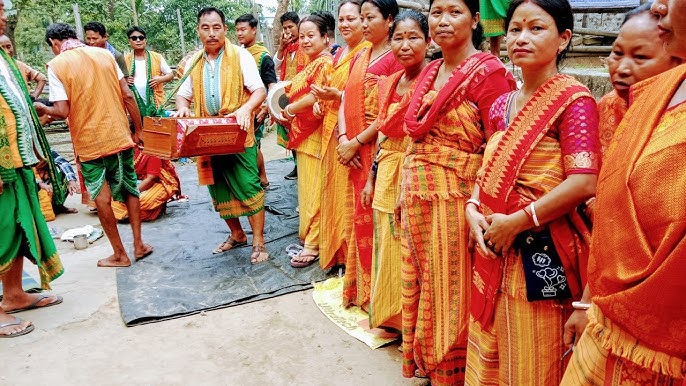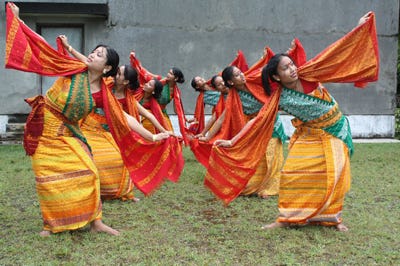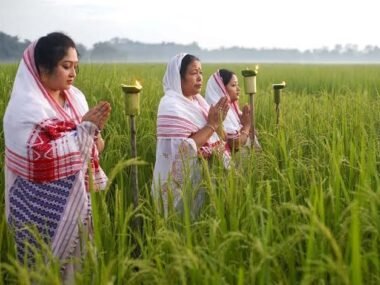
Bohaggiyo Bishu, also known as Bohag Bihu, is one of the most celebrated and significant festivals in Assam, especially among the Bodo community. It marks the onset of the Bihu season, which is an important agricultural festival celebrated by the people of Assam. The festival signifies the arrival of spring and is a time of renewal, prosperity, and gratitude for the harvest. The festival is not just a social occasion, but also carries profound cultural, religious, and agricultural importance.
The Historical and Cultural Significance of Bohaggiyo Bishu
Bohaggiyo Bishu marks the beginning of the Assamese New Year and is celebrated during the month of Bohag (usually in mid-April). This is the time when the sun moves into the Aries zodiac, heralding the start of the harvest season and the arrival of the spring. The festival is primarily agricultural, with offerings to ensure a bountiful harvest. The Bodo people, like many others in Assam, view this time as a season of renewal and prosperity.
Bihu is not only a time for feasting and celebration, but it also symbolizes a deep connection with nature and the earth. For the Bodo community, this festival holds a special place, reflecting their rich traditions, customs, and way of life. Bohaggiyo Bishu, in particular, is a blend of traditional rituals and community spirit, where people unite to celebrate life, love, and harvest.
Rituals and Traditions of Bohaggiyo Bishu
The festival begins with rituals aimed at seeking blessings from the divine for a successful harvest. People clean their homes and yards, cook traditional dishes, and prepare for the grand celebrations. These rituals are meant to honor Maidong, the God of Agriculture, and Bisu Dewal, the goddess of prosperity. Offerings such as newly harvested rice, fruits, and other farm products are presented during these ceremonies to ensure a bountiful crop for the coming year.
On the first day of Bohaggiyo Bishu, Bodo people clean their homes, prepare traditional foods, and gather with family members. It is customary to wear new clothes to mark the beginning of the Assamese New Year. Traditional dances and music are also an integral part of the celebrations, with the Bodo dance being performed to express joy and thanksgiving.
Bodo Cuisine: A Feast for the Festival
Food plays a central role in Bohaggiyo Bishu celebrations. People prepare a variety of traditional Bodo dishes, including Pitha (rice cakes), Laru (sweet rice balls), Bamkuchang (a type of meat curry), and a variety of vegetable and fish preparations. The food is often served in a communal manner, fostering a sense of togetherness among friends and family.
One of the most important foods prepared during the festival is the Bihu Mitha, which includes sweets like Pitha, Til Laru (sesame and jaggery balls), and Mitha Pitha (sweet rice cakes). These sweet delicacies are enjoyed by all, symbolizing the sweetness of life and the prosperity that the new season brings.
Bohaggiyo Bishu and Community Celebrations
Bohaggiyo Bishu is not just a family affair; it is also a time for the community to come together. Public celebrations are held in villages and towns, where people participate in cultural events, dances, and music performances. The famous Bodo dance—a vibrant and rhythmic dance—can be seen in full swing, where people of all ages join in, wearing colorful traditional costumes. The Bihu dance, with its energetic steps, is performed to the beat of traditional drums like the Dhol, Taal, and Bahi.
In many places, cattle fairs and marketplaces are organized, where people sell agricultural produce and handmade goods. These fairs become vibrant community hubs, with music, dance, and exchanges of goods that highlight the close-knit nature of the Bodo community.
Bohaggiyo Bishu in the Modern Era
While Bohaggiyo Bishu continues to retain its traditional significance, the festival has also adapted to the modern era. Today, it is celebrated with modern influences like street performances, stage shows, and public gatherings that bring together people of all communities. The use of social media and online platforms has further amplified the festival, helping people from all over the world connect with the celebrations in Assam.
Despite these modern influences, the core values of the festival remain unchanged. It continues to be a time for people to come together, to celebrate the end of the agricultural season, to express gratitude for the harvest, and to pray for a prosperous future. This intergenerational bond of tradition is a key aspect that defines Bohaggiyo Bishu, and it plays an important role in keeping the culture and heritage of the Bodo community alive.
Symbolism of Bohaggiyo Bishu: A Festival of Prosperity and Renewal
Bohaggiyo Bishu is more than just a festival; it is a celebration of life itself. The rituals, the food, the music, and the dances all serve as reminders of the connection between the people, the land, and the seasons. The festival is a tribute to the labor of the farmers who work tirelessly to cultivate the fields, and it is a time to honor the natural forces that sustain life.
The spiritual aspects of Bohaggiyo Bishu also emphasize renewal and transformation. The festival represents the cyclical nature of life, where one season ends, and a new one begins. Just as the old crops are harvested, so too is the opportunity to start anew. Bohaggiyo Bishu encourages individuals to reflect on the past year, seek blessings for a good future, and renew their commitment to family, community, and the earth.
Conclusion: Bohaggiyo Bishu – A Festival of Unity, Tradition, and Hope
Bohaggiyo Bishu is more than just a harvest festival; it is a reflection of the Bodo people’s deep connection with their traditions, their land, and their community. The festival brings together people of all ages to celebrate life, family, and the harvest. With its rich customs, rituals, music, and dances, Bohaggiyo Bishu serves as a reminder of the resilience and spirit of the Assamese people and their enduring bond with nature.
As the people of Assam celebrate Bohaggiyo Bishu with joy and enthusiasm, they carry forward the cultural legacy of their ancestors, ensuring that the spirit of renewal, prosperity, and hope continues to thrive in the years to come.
FAQ’s
Q. What is Bohaggiyo Bishu?
Bohaggiyo Bishu, also known as Bohag Bihu, is a major festival in Assam, especially celebrated by the Bodo community. It marks the arrival of spring and the beginning of the Assamese New Year, with rituals focused on agriculture and harvest.
Q. When is Bohaggiyo Bishu celebrated?
Bohaggiyo Bishu is celebrated during the month of Bohag, which typically falls in mid-April. It marks the beginning of the Bihu season and the start of the harvest cycle.
Q. What are the main rituals of Bohaggiyo Bishu?
The main rituals include cleaning homes, offering prayers to Maidong (God of Agriculture) and Bisu Dewal (Goddess of Prosperity), and preparing traditional foods. People also wear new clothes and celebrate with family and friends.
Q. What foods are prepared during Bohaggiyo Bishu?
Popular foods include Pitha (rice cakes), Laru (sweet rice balls), Bamkuchang (meat curry), Bihu Mitha (sweet delicacies like Til Laru), and various vegetable and fish dishes. These foods symbolize prosperity and renewal.
Q. Why is Bohaggiyo Bishu important for the Bodo community?
Bohaggiyo Bishu holds great cultural, agricultural, and religious significance for the Bodo people. It marks the beginning of the new harvest season, symbolizing hope, renewal, and prosperity for the community.












